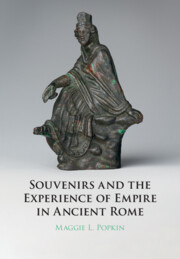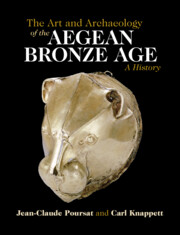Refine search
Actions for selected content:
5894 results in Classical art and architecture
Chapter 18 - Mainland Greece and the Islands in the First Palace Period
- from Part III - Aegean Art in the Cretan First Palace Period
-
- Book:
- The Art and Archaeology of the Aegean Bronze Age
- Published online:
- 19 May 2022
- Print publication:
- 09 June 2022, pp 123-128
-
- Chapter
- Export citation
Part VIII - Aegean Art at the End of the Bronze Age
-
- Book:
- The Art and Archaeology of the Aegean Bronze Age
- Published online:
- 19 May 2022
- Print publication:
- 09 June 2022, pp 485-520
-
- Chapter
- Export citation
Part II - The Art of the Aegean Early Bronze Age
-
- Book:
- The Art and Archaeology of the Aegean Bronze Age
- Published online:
- 19 May 2022
- Print publication:
- 09 June 2022, pp 33-80
-
- Chapter
- Export citation
Part IV - Aegean Art in the Second Palace Period
-
- Book:
- The Art and Archaeology of the Aegean Bronze Age
- Published online:
- 19 May 2022
- Print publication:
- 09 June 2022, pp 129-262
-
- Chapter
- Export citation
Part VI - Aegean Art in the Final Palatial Period of Knossos
-
- Book:
- The Art and Archaeology of the Aegean Bronze Age
- Published online:
- 19 May 2022
- Print publication:
- 09 June 2022, pp 327-390
-
- Chapter
- Export citation
Chapter 38 - Other Relief Arts
- from Part VI - Aegean Art in the Final Palatial Period of Knossos
-
- Book:
- The Art and Archaeology of the Aegean Bronze Age
- Published online:
- 19 May 2022
- Print publication:
- 09 June 2022, pp 373-378
-
- Chapter
- Export citation
Figures
-
- Book:
- The Art and Archaeology of the Aegean Bronze Age
- Published online:
- 19 May 2022
- Print publication:
- 09 June 2022, pp x-xxii
-
- Chapter
- Export citation
Chapter 27 - Funerary Architecture
- from Part V - Aegean Art in the Cretan Second Palace Period
-
- Book:
- The Art and Archaeology of the Aegean Bronze Age
- Published online:
- 19 May 2022
- Print publication:
- 09 June 2022, pp 271-281
-
- Chapter
- Export citation
Part III - Aegean Art in the Cretan First Palace Period
-
- Book:
- The Art and Archaeology of the Aegean Bronze Age
- Published online:
- 19 May 2022
- Print publication:
- 09 June 2022, pp 81-128
-
- Chapter
- Export citation
Chapter 55 - Mycenaean Art and Its Legacy
- from Part VIII - Aegean Art at the End of the Bronze Age
-
- Book:
- The Art and Archaeology of the Aegean Bronze Age
- Published online:
- 19 May 2022
- Print publication:
- 09 June 2022, pp 515-520
-
- Chapter
- Export citation
Chapter 35 - The Frescoes
- from Part VI - Aegean Art in the Final Palatial Period of Knossos
-
- Book:
- The Art and Archaeology of the Aegean Bronze Age
- Published online:
- 19 May 2022
- Print publication:
- 09 June 2022, pp 345-355
-
- Chapter
- Export citation
Chapter 42 - Architecture
- from Part VII - Aegean Art of the Mainland Mycenaean Palatial Period
-
- Book:
- The Art and Archaeology of the Aegean Bronze Age
- Published online:
- 19 May 2022
- Print publication:
- 09 June 2022, pp 398-416
-
- Chapter
- Export citation
Chapter 45 - Mycenaean Ivories of LH IIIA2–B
- from Part VII - Aegean Art of the Mainland Mycenaean Palatial Period
-
- Book:
- The Art and Archaeology of the Aegean Bronze Age
- Published online:
- 19 May 2022
- Print publication:
- 09 June 2022, pp 437-444
-
- Chapter
- Export citation
Postface. Minor Gestures, Minor Media
-
-
- Book:
- Camering Fernand Deligny on Cinema and the Image
- Published by:
- Amsterdam University Press
- Published online:
- 16 November 2022
- Print publication:
- 09 June 2022, pp 239-250
-
- Chapter
- Export citation
Chapter 2 - Architectural Beginnings
- from Part I - Aegean Neolithic Art
-
- Book:
- The Art and Archaeology of the Aegean Bronze Age
- Published online:
- 19 May 2022
- Print publication:
- 09 June 2022, pp 15-17
-
- Chapter
- Export citation
Part VII - Aegean Art of the Mainland Mycenaean Palatial Period
-
- Book:
- The Art and Archaeology of the Aegean Bronze Age
- Published online:
- 19 May 2022
- Print publication:
- 09 June 2022, pp 391-484
-
- Chapter
- Export citation
Chapter 37 - Creto-Mycenaean Glyptic in LM II/LH IIB–IIIA1
- from Part VI - Aegean Art in the Final Palatial Period of Knossos
-
- Book:
- The Art and Archaeology of the Aegean Bronze Age
- Published online:
- 19 May 2022
- Print publication:
- 09 June 2022, pp 364-372
-
- Chapter
- Export citation

Souvenirs and the Experience of Empire in Ancient Rome
-
- Published online:
- 20 May 2022
- Print publication:
- 21 April 2022

The Art and Archaeology of the Aegean Bronze Age
- A History
-
- Published online:
- 19 May 2022
- Print publication:
- 09 June 2022
Figures
-
- Book:
- Human-Animal Relations in Bronze Age Crete
- Published online:
- 28 April 2022
- Print publication:
- 12 May 2022, pp vii-viii
-
- Chapter
- Export citation
